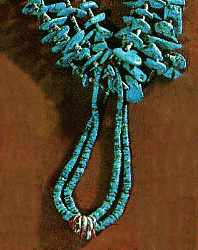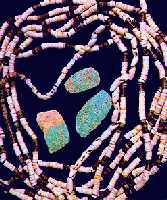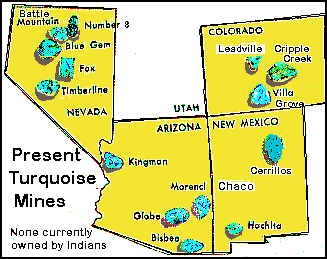
TURQUOISE ROAD:
MINING,
TRADING
| Page Buttons |
|---|
 |
Stone and shell beads are among the most ancient artifacts to have survived. They are used by archaeologists as clues to ancient trade routes, since they are often made of non-local materials. This 14-foot long necklace of stone beads (left), with three large chunks of turquoise was found in a wall niche in the ruins of an Anasazi kiva town, Chetro Ketl, at the great complex of abandoned towns in Chaco Canyon, New Mexico, now a National park |
|---|---|
| The beads and turquoise weren't forgotten and left behind when Chetro Ketl, with its Great Kiva, was -- like all the other Anasazi towns-- abandoned around 1200. The great Kiva has a number of niches built into its inner wall, with large bead and turquoise necklaces put inside, then the niches were walled up with masonry. Obviously an offering to honor the spirits worshipped in the Great Kiva. You can explore Chetro Ketl's Great Kiva in a 3D computer simulation.
Mined at a huge underground mine at Cerrillos (near Santa Fe), turquois was the basis of the large civilization that grew as a complex of towns and ceremonial and trade-center cities in Chaco canyon, center of a rocky desert. Find out more about it, see many pictures, here. Turquoise is a hydrous aluminum sulphate, colored by copper salts. It is found in many desert regions of the world, and was prized as a gem by ancient India, China, and Persia, in addition to the southwest (and trading routes). Its primary use is personal, but it is also offered to the spirits, and crushed for use in ceremonial and healing sandpaintings. Dissolved in water, the chemical compound is deposited into veins in porous rock called matrix or mother. This mother rock is responsible for the dark lines and blotches, which may include iron pyrites or bits of quartz. Colors run from pale blue to dark green. Quality of the stone depends on color, hardness and matrix. The most highly prized is a deep blue with dark spider web. Softer stones change color after long contact with body oils and soap to a dark green. | |
 | |
|
Cerrillos, the largest of the early mines, extends 200 feet underground, and is 300 feet wide. Mining was done with stone hammers and antler picks, with fire used to crack the rock that holds the gem. Around 700 AD, the Chaco people began to build up the complex -- eventually 9 large "apartment house" towns and dozens of outlying villages. Long roads, which the population traveled to visit the annual trade fairs and spiritual ceremonies culturally and conomically united a huge area -- more than 400 miles of roads covering 100,000 square miles. See a map of Anasazi and contemporary cultural areas. From about 900 AD on, it was a turquoise-based civilization, with major trade taking place across the "turquoise road" south over the Sierra Madre, to the main customers: merchant towns in Mexico, especially Tollan (Tula), the Toltec capital on Lake Texcoco, in the central Valley of Mexico. This turquoise trade -- and turquoise as personal liquid asset, functioning like money -- was the wealth and basis of the Anasazi civilization. That wealth was gathered by carefully controlling the turquoise output of the Cerrillos mine and by the fact that people in the thousands of outlying small farming villages gladly trekked to Chaco for festivals and trade fairs -- bringing all their surplus food and other goods to trade for religiously-valued turquoise. | |
| Continue | |
